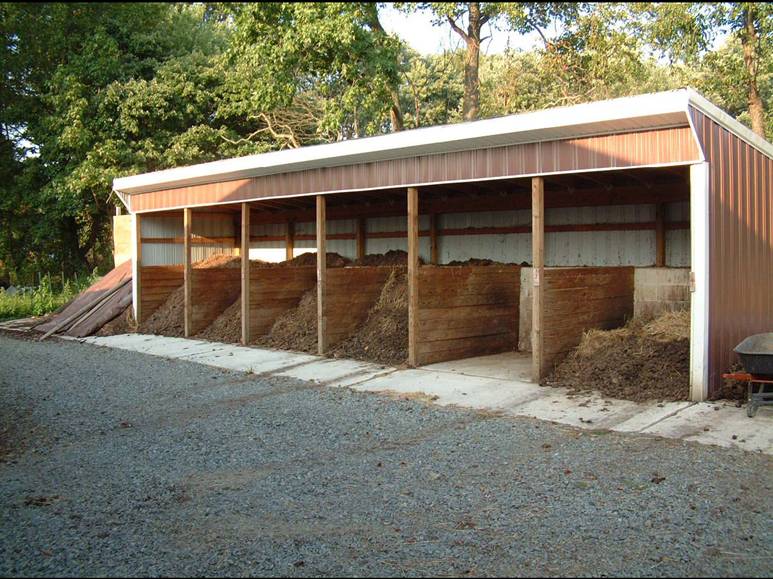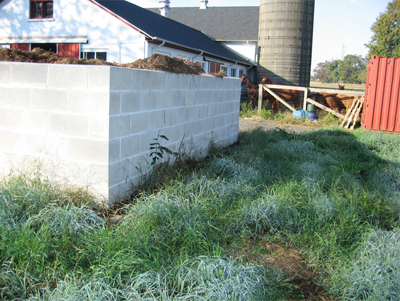- Research
- >
- Ryders Lane Farm
- >
- Manure Management
Plan of Action for Manure Management

Incorporating Composting into your farm management plan will provide a valuable source of nutrients for pastures and assist with manure disposal.
A whole-farm nutrient management plan was developed with the assistance of the Natural Resources Conservation Service (NRCS), with particular focus on:
- Short and long-term manure storage, including storage structure design
- Design of composting sites, as well as plans for use of compost and manure
- Proper manure disposal
- Soil nutrient level maintenance
- Little or no risk of water contamination
Short Term Manure Storage Structure
The new manure storage structure was completed near the Ryders Lane Equine Facility at the end of September 2006. The old facility was too small and was located in such a place that all runoff leaching from the manure pile (which, owing to the small size of the storage, was substantial) ran down the animal lanes and into a waterway.
The new structure is much larger than its predecessor. It has the capacity to hold manure and bedding from 17 horses kept in stalls for 24 hours a day for up to 45 days. This design allows for flexibility with farm animal density while maintaining environmental quality.
Additionally, the new structure is located farther away from the Ryders Lane Barn, allowing for vegetative buffers composed of cool-season grasses to surround the storage area. Drainage spaces in the back and side walls, along with the slope of the pit itself, allow runoff to proceed through the buffers, which will prevent contamination of animal movement lanes and local waterways.
Manure Storage pit buffer
The new manure storage pit requires drain holes to prevent rainfall from pooling in the pit, and instead exits out the back due to the slight slope of the floor of the pit. This requires a vegetative buffer to be planted where the nutrients from the manure can be taken up by the plants allowing clean water to enter our lakes and streams and ensuring that all runoff from the facility will not contaminate animal movement lanes or waterways.
Our buffer was designed according to NRCS size and grass composition:
The buffer extends 35 feet behind the pit down a gradual slope and should be at least the width of the manure pit (see photo).
The vegetative buffer is composed of cool-season grasses and legumes including white clover (2 lb/acre), orchard grass (6 lb/acre), and smooth brome (6 lb/acre).
Buffers of this kind need to be fenced off from horses and other livestock and maintained with a mower as needed. Hand grazing of the buffer by horses is acceptable, as long as it is not used as a pasture and any manure is picked up.
Rutgers CNMP
A Comprehensive Nutrient Management Plan (CNMP) describes and documents a conservation system within a conservation plan that is unique to animal feeding operations.
-
At a minimum, a CNMP must address quality criteria to the sustainable level for soil erosion and water quality for the planning unit associated with the animal feeding operation. Conservation planning activities associated with the development of a CNMP, however, should attempt to achieve a CNMP that addresses quality criteria for all five natural resources (soil, water, air, plants, and animals).
-
Any CNMP that is developed by NRCS (Natural Resources Conservation Service) or partner employee will have the plan approved by a NRCS certified conservation planner.
A CNMP may be comprised of six possible elements:
-
Manure and Wastewater Handling and Storage
-
Land Treatment Practices
-
Nutrient Management
-
Record Keeping
-
Feed Management
-
Other Utilization Options


